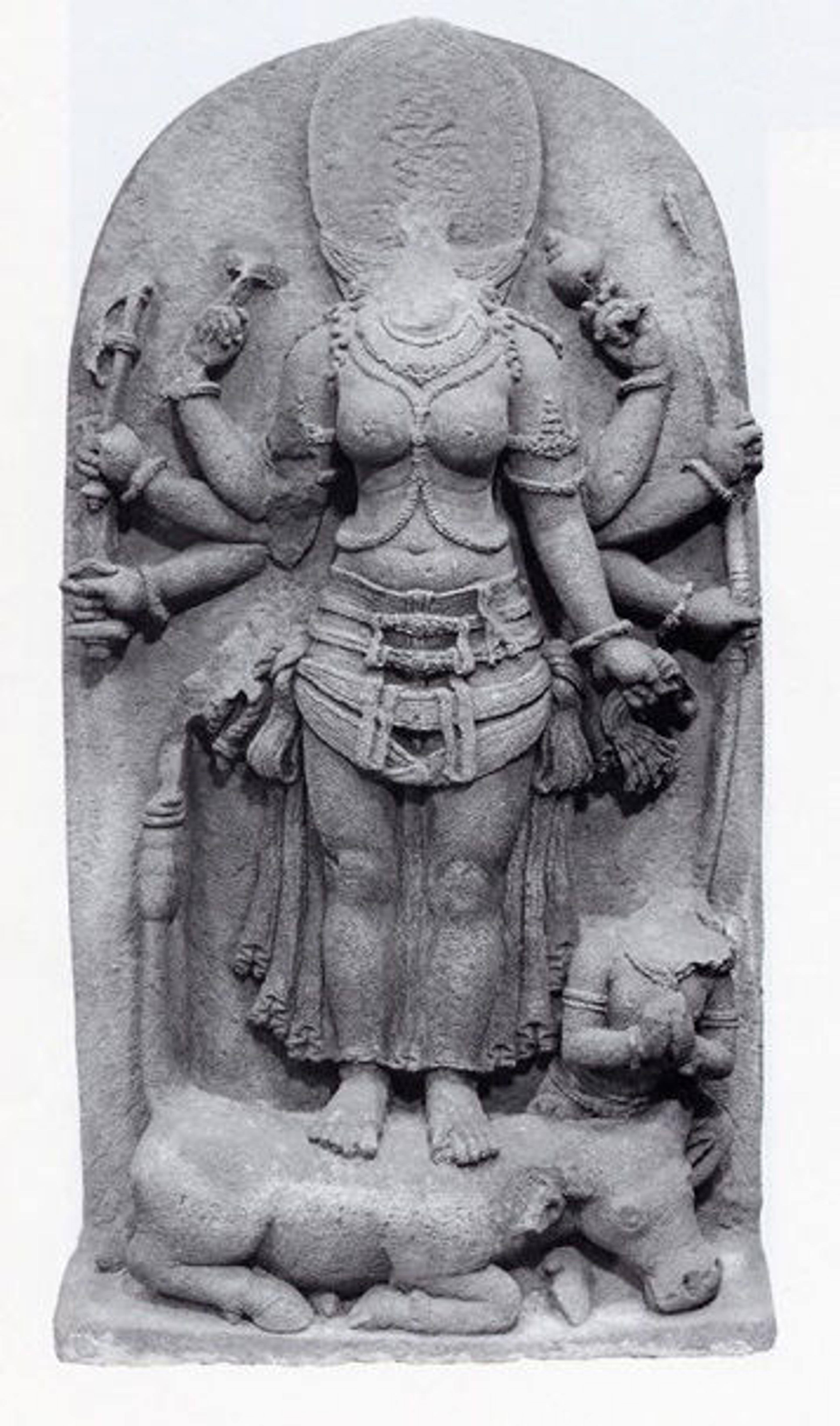
Alexandre Cabanel (French, 1823–1889). The Birth of Venus, 1875. Oil on canvas; 41 3/4 x 71 7/8 in. (106 x 182.6 cm). The Metropolitan Museum of Art, New York, Gift of John Wolfe, 1893 (94.24.1)
«The nudity seen in film provokes a different reaction than the nudity found in paintings. Audiences see Margot Robbie in The Wolf of Wall Street as a sex symbol, yet find no scandal in the nudity in a painting such as Alexandre Cabanel's The Birth of Venus. Why is this? Why do we think of scantily dressed women in advertisements as objectified and singers like Beyoncé wearing risqué outfits as empowered? Why are we outraged by the portrayal of women in music videos, yet we don't bat an eye when we see nude women in artworks? We decided to explore these contradictions by asking ourselves, "What role does nudity play in coloring our perception of both a work of art and the world?"»

The first artwork we looked at was the goddess Durga victorious over the buffalo demon, Mahisha (Mahishasuramardini), a large, semi-nude statue of the Hindu goddess Durga. The statue depicts a triumphant goddess standing tall and proud over the body of a slain buffalo demon. Her many hands hold a variety of different weapons. She also wears relatively little clothing; her breasts are in full view, and she is adorned with jewelry. When we first saw her, we assumed she was being sexualized due to her lack of clothing, but Associate Curator Kurt Behrendt told us that the statue was created to praise and honor the goddess, not to sexualize her.
Right: The goddess Durga victorious over the Buffalo Demon, Mahisha (Mahishasuramardini), 9th century. Central Javanese period. Indonesia (Java). Volcanic stone (Andesite); 60 1/32 in. (152.5 cm). Purchase, Friends of Asian Art Gifts, Mr. and Mrs. Donald Bruckmann, Mr. and Mrs. Perry J. Lewis, and Anonymous Gifts, 1988 (1988.160)
Looking again with a new perception, we understood what Behrendt meant. Even though she is depicted clad in nothing more than a loose, jewel-adorned skirt, Durga's strong gaze and posture shows that she was respected as a powerful warrior. Her stance over the defeated buffalo demon shows her prowess in battle while retaining her beauty. Overall, we found that the statue portrays Durga as powerful despite the fact that she is nude. We could see that she was feared, awed, worshiped, and exalted.
With this in mind, we turned to look at another work of art: Antonio Canova's Perseus with the head of Medusa. Perseus stands tall in his muscular glory holding the head of the gorgon Medusa. When we first see him, we think heroic, powerful, and fearsome. His statue exemplifies the triumphant battle between him and the fiendish monster. We asked ourselves, "Does Perseus's nudity define him? Does he seem objectified?" We didn't think so.

Antonio Canova (Italian, 1757–1822). Perseus with the head of Medusa, 1804–6. Marble; Overall (confirmed): H. 95 1/2 x W. 75 1/2 x D. 40 1/2 in. (242.6 x 191.8 x 102.9 cm). The Metropolitan Museum of Art, New York, Fletcher Fund, 1967 (67.110.1)
Why does Durga's nudity overshadow her story? Both of these figures slayed an evil entity while nude, but we saw them differently. When we looked at Perseus, we recalled only his victorious battle. His nudity was ignored and his story absorbed. When we looked at Durga, we focused on her body and not on her triumph over the demon. Is there a problem with our perception?
Comparing Durga and Perseus made it clear that the issue is not the nudity itself, but how we perceive it. Just because a subject is nude does not necessarily mean that the subject is being exploited; rather, it all depends on how you look at it. This is true not only of art, but also of the modern world and, in particular, celebrities. Opinions on Beyoncé, as an example, vary based on what people know or choose to believe about her. If two people watch Beyoncé's music video "Single Ladies," they may have two completely different views on whether Beyoncé is empowered or being exploited. One person might applaud the message of the song and not care about the choreography and fashion, and the other may feel outraged by what Beyoncé and her dancers are wearing. Even today, we sometimes unconsciously value a woman's appearance over her message.
When we first encountered Durga, our group believed she was being sexualized by the artist, but after learning more, we began to wonder if perhaps Durga's nudity was empowering. We soon realized that there was no right answer: Durga is neither fully empowered or exploited by her nudity. It is not important for us to label her as one or the other. The importance lies in recognizing that whether you're looking at an iconic pop star or an ancient statue, things are never as simple as they first appear to be.
